Lingjuan Lyu
StelLA: Subspace Learning in Low-rank Adaptation using Stiefel Manifold
Oct 02, 2025Abstract:Low-rank adaptation (LoRA) has been widely adopted as a parameter-efficient technique for fine-tuning large-scale pre-trained models. However, it still lags behind full fine-tuning in performance, partly due to its insufficient exploitation of the geometric structure underlying low-rank manifolds. In this paper, we propose a geometry-aware extension of LoRA that uses a three-factor decomposition $U\!SV^\top$. Analogous to the structure of singular value decomposition (SVD), it separates the adapter's input and output subspaces, $V$ and $U$, from the scaling factor $S$. Our method constrains $U$ and $V$ to lie on the Stiefel manifold, ensuring their orthonormality throughout the training. To optimize on the Stiefel manifold, we employ a flexible and modular geometric optimization design that converts any Euclidean optimizer to a Riemannian one. It enables efficient subspace learning while remaining compatible with existing fine-tuning pipelines. Empirical results across a wide range of downstream tasks, including commonsense reasoning, math and code generation, image classification, and image generation, demonstrate the superior performance of our approach against the recent state-of-the-art variants of LoRA. Code is available at https://github.com/SonyResearch/stella.
UNIFORM: Unifying Knowledge from Large-scale and Diverse Pre-trained Models
Aug 27, 2025Abstract:In the era of deep learning, the increasing number of pre-trained models available online presents a wealth of knowledge. These models, developed with diverse architectures and trained on varied datasets for different tasks, provide unique interpretations of the real world. Their collective consensus is likely universal and generalizable to unseen data. However, effectively harnessing this collective knowledge poses a fundamental challenge due to the heterogeneity of pre-trained models. Existing knowledge integration solutions typically rely on strong assumptions about training data distributions and network architectures, limiting them to learning only from specific types of models and resulting in data and/or inductive biases. In this work, we introduce a novel framework, namely UNIFORM, for knowledge transfer from a diverse set of off-the-shelf models into one student model without such constraints. Specifically, we propose a dedicated voting mechanism to capture the consensus of knowledge both at the logit level -- incorporating teacher models that are capable of predicting target classes of interest -- and at the feature level, utilizing visual representations learned on arbitrary label spaces. Extensive experiments demonstrate that UNIFORM effectively enhances unsupervised object recognition performance compared to strong knowledge transfer baselines. Notably, it exhibits remarkable scalability by benefiting from over one hundred teachers, while existing methods saturate at a much smaller scale.
Seeing Further on the Shoulders of Giants: Knowledge Inheritance for Vision Foundation Models
Aug 20, 2025Abstract:Vision foundation models (VFMs) are predominantly developed using data-centric methods. These methods require training on vast amounts of data usually with high-quality labels, which poses a bottleneck for most institutions that lack both large-scale data and high-end GPUs. On the other hand, many open-source vision models have been pretrained on domain-specific data, enabling them to distill and represent core knowledge in a form that is transferable across diverse applications. Even though these models are highly valuable assets, they remain largely under-explored in empowering the development of a general-purpose VFM. In this paper, we presents a new model-driven approach for training VFMs through joint knowledge transfer and preservation. Our method unifies multiple pre-trained teacher models in a shared latent space to mitigate the ``imbalanced transfer'' issue caused by their distributional gaps. Besides, we introduce a knowledge preservation strategy to take a general-purpose teacher as a knowledge base for integrating knowledge from the remaining purpose-specific teachers using an adapter module. By unifying and aggregating existing models, we build a powerful VFM to inherit teachers' expertise without needing to train on a large amount of labeled data. Our model not only provides generalizable visual features, but also inherently supports multiple downstream tasks. Extensive experiments demonstrate that our VFM outperforms existing data-centric models across four fundamental vision tasks, including image classification, object detection, semantic and instance segmentation.
Investigating the Design Space of Visual Grounding in Multimodal Large Language Model
Aug 11, 2025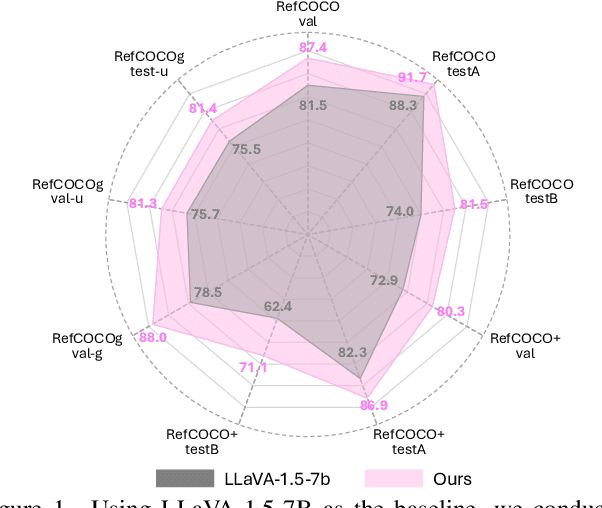
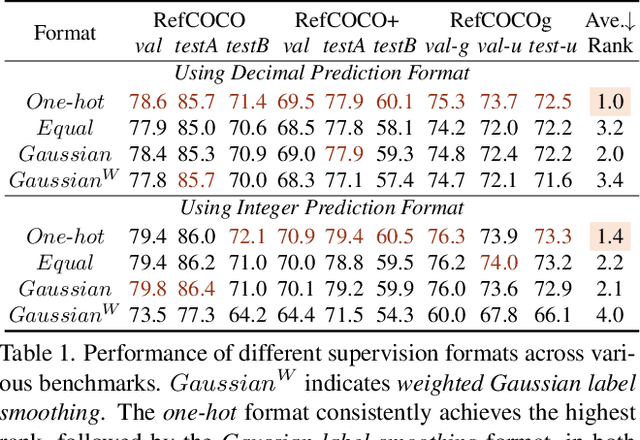
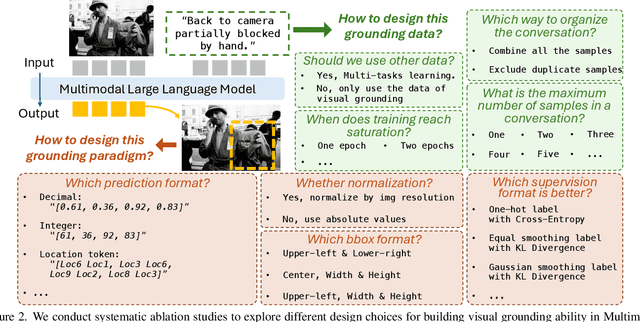
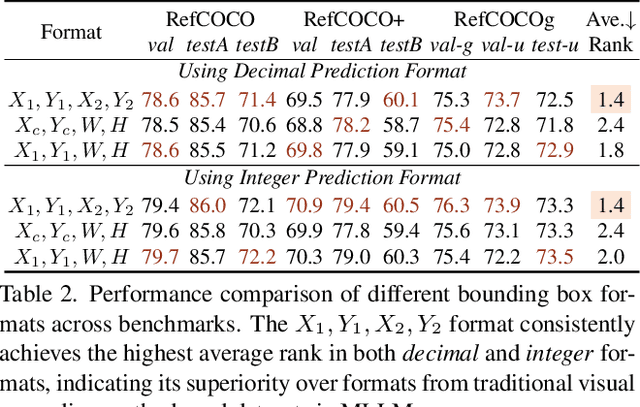
Abstract:Fine-grained multimodal capability in Multimodal Large Language Models (MLLMs) has emerged as a critical research direction, particularly for tackling the visual grounding (VG) problem. Despite the strong performance achieved by existing approaches, they often employ disparate design choices when fine-tuning MLLMs for VG, lacking systematic verification to support these designs. To bridge this gap, this paper presents a comprehensive study of various design choices that impact the VG performance of MLLMs. We conduct our analysis using LLaVA-1.5, which has been widely adopted in prior empirical studies of MLLMs. While more recent models exist, we follow this convention to ensure our findings remain broadly applicable and extendable to other architectures. We cover two key aspects: (1) exploring different visual grounding paradigms in MLLMs, identifying the most effective design, and providing our insights; and (2) conducting ablation studies on the design of grounding data to optimize MLLMs' fine-tuning for the VG task. Finally, our findings contribute to a stronger MLLM for VG, achieving improvements of +5.6% / +6.9% / +7.0% on RefCOCO/+/g over the LLaVA-1.5.
LIFEBench: Evaluating Length Instruction Following in Large Language Models
May 22, 2025Abstract:While large language models (LLMs) can solve PhD-level reasoning problems over long context inputs, they still struggle with a seemingly simpler task: following explicit length instructions-e.g., write a 10,000-word novel. Additionally, models often generate far too short outputs, terminate prematurely, or even refuse the request. Existing benchmarks focus primarily on evaluating generations quality, but often overlook whether the generations meet length constraints. To this end, we introduce Length Instruction Following Evaluation Benchmark (LIFEBench) to comprehensively evaluate LLMs' ability to follow length instructions across diverse tasks and a wide range of specified lengths. LIFEBench consists of 10,800 instances across 4 task categories in both English and Chinese, covering length constraints ranging from 16 to 8192 words. We evaluate 26 widely-used LLMs and find that most models reasonably follow short-length instructions but deteriorate sharply beyond a certain threshold. Surprisingly, almost all models fail to reach the vendor-claimed maximum output lengths in practice, as further confirmed by our evaluations extending up to 32K words. Even long-context LLMs, despite their extended input-output windows, counterintuitively fail to improve length-instructions following. Notably, Reasoning LLMs outperform even specialized long-text generation models, achieving state-of-the-art length following. Overall, LIFEBench uncovers fundamental limitations in current LLMs' length instructions following ability, offering critical insights for future progress.
DD-Ranking: Rethinking the Evaluation of Dataset Distillation
May 19, 2025Abstract:In recent years, dataset distillation has provided a reliable solution for data compression, where models trained on the resulting smaller synthetic datasets achieve performance comparable to those trained on the original datasets. To further improve the performance of synthetic datasets, various training pipelines and optimization objectives have been proposed, greatly advancing the field of dataset distillation. Recent decoupled dataset distillation methods introduce soft labels and stronger data augmentation during the post-evaluation phase and scale dataset distillation up to larger datasets (e.g., ImageNet-1K). However, this raises a question: Is accuracy still a reliable metric to fairly evaluate dataset distillation methods? Our empirical findings suggest that the performance improvements of these methods often stem from additional techniques rather than the inherent quality of the images themselves, with even randomly sampled images achieving superior results. Such misaligned evaluation settings severely hinder the development of DD. Therefore, we propose DD-Ranking, a unified evaluation framework, along with new general evaluation metrics to uncover the true performance improvements achieved by different methods. By refocusing on the actual information enhancement of distilled datasets, DD-Ranking provides a more comprehensive and fair evaluation standard for future research advancements.
Sybil-based Virtual Data Poisoning Attacks in Federated Learning
May 15, 2025



Abstract:Federated learning is vulnerable to poisoning attacks by malicious adversaries. Existing methods often involve high costs to achieve effective attacks. To address this challenge, we propose a sybil-based virtual data poisoning attack, where a malicious client generates sybil nodes to amplify the poisoning model's impact. To reduce neural network computational complexity, we develop a virtual data generation method based on gradient matching. We also design three schemes for target model acquisition, applicable to online local, online global, and offline scenarios. In simulation, our method outperforms other attack algorithms since our method can obtain a global target model under non-independent uniformly distributed data.
SacFL: Self-Adaptive Federated Continual Learning for Resource-Constrained End Devices
May 01, 2025



Abstract:The proliferation of end devices has led to a distributed computing paradigm, wherein on-device machine learning models continuously process diverse data generated by these devices. The dynamic nature of this data, characterized by continuous changes or data drift, poses significant challenges for on-device models. To address this issue, continual learning (CL) is proposed, enabling machine learning models to incrementally update their knowledge and mitigate catastrophic forgetting. However, the traditional centralized approach to CL is unsuitable for end devices due to privacy and data volume concerns. In this context, federated continual learning (FCL) emerges as a promising solution, preserving user data locally while enhancing models through collaborative updates. Aiming at the challenges of limited storage resources for CL, poor autonomy in task shift detection, and difficulty in coping with new adversarial tasks in FCL scenario, we propose a novel FCL framework named SacFL. SacFL employs an Encoder-Decoder architecture to separate task-robust and task-sensitive components, significantly reducing storage demands by retaining lightweight task-sensitive components for resource-constrained end devices. Moreover, $\rm{SacFL}$ leverages contrastive learning to introduce an autonomous data shift detection mechanism, enabling it to discern whether a new task has emerged and whether it is a benign task. This capability ultimately allows the device to autonomously trigger CL or attack defense strategy without additional information, which is more practical for end devices. Comprehensive experiments conducted on multiple text and image datasets, such as Cifar100 and THUCNews, have validated the effectiveness of $\rm{SacFL}$ in both class-incremental and domain-incremental scenarios. Furthermore, a demo system has been developed to verify its practicality.
Unlearning through Knowledge Overwriting: Reversible Federated Unlearning via Selective Sparse Adapter
Feb 28, 2025



Abstract:Federated Learning is a promising paradigm for privacy-preserving collaborative model training. In practice, it is essential not only to continuously train the model to acquire new knowledge but also to guarantee old knowledge the right to be forgotten (i.e., federated unlearning), especially for privacy-sensitive information or harmful knowledge. However, current federated unlearning methods face several challenges, including indiscriminate unlearning of cross-client knowledge, irreversibility of unlearning, and significant unlearning costs. To this end, we propose a method named FUSED, which first identifies critical layers by analyzing each layer's sensitivity to knowledge and constructs sparse unlearning adapters for sensitive ones. Then, the adapters are trained without altering the original parameters, overwriting the unlearning knowledge with the remaining knowledge. This knowledge overwriting process enables FUSED to mitigate the effects of indiscriminate unlearning. Moreover, the introduction of independent adapters makes unlearning reversible and significantly reduces the unlearning costs. Finally, extensive experiments on three datasets across various unlearning scenarios demonstrate that FUSED's effectiveness is comparable to Retraining, surpassing all other baselines while greatly reducing unlearning costs.
CopyJudge: Automated Copyright Infringement Identification and Mitigation in Text-to-Image Diffusion Models
Feb 21, 2025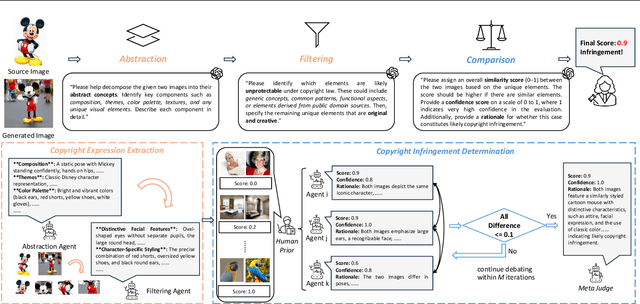
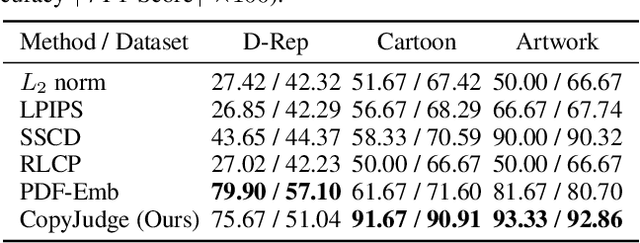
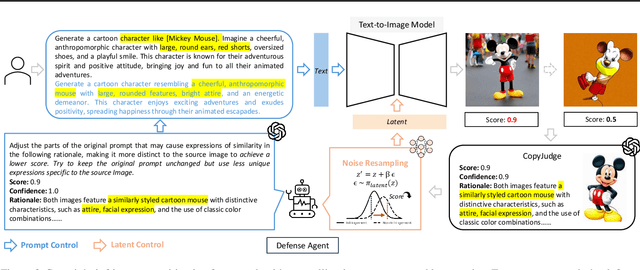

Abstract:Assessing whether AI-generated images are substantially similar to copyrighted works is a crucial step in resolving copyright disputes. In this paper, we propose CopyJudge, an automated copyright infringement identification framework that leverages large vision-language models (LVLMs) to simulate practical court processes for determining substantial similarity between copyrighted images and those generated by text-to-image diffusion models. Specifically, we employ an abstraction-filtration-comparison test framework with multi-LVLM debate to assess the likelihood of infringement and provide detailed judgment rationales. Based on the judgments, we further introduce a general LVLM-based mitigation strategy that automatically optimizes infringing prompts by avoiding sensitive expressions while preserving the non-infringing content. Besides, our approach can be enhanced by exploring non-infringing noise vectors within the diffusion latent space via reinforcement learning, even without modifying the original prompts. Experimental results show that our identification method achieves comparable state-of-the-art performance, while offering superior generalization and interpretability across various forms of infringement, and that our mitigation method could more effectively mitigate memorization and IP infringement without losing non-infringing expressions.
 Add to Chrome
Add to Chrome Add to Firefox
Add to Firefox Add to Edge
Add to Edge